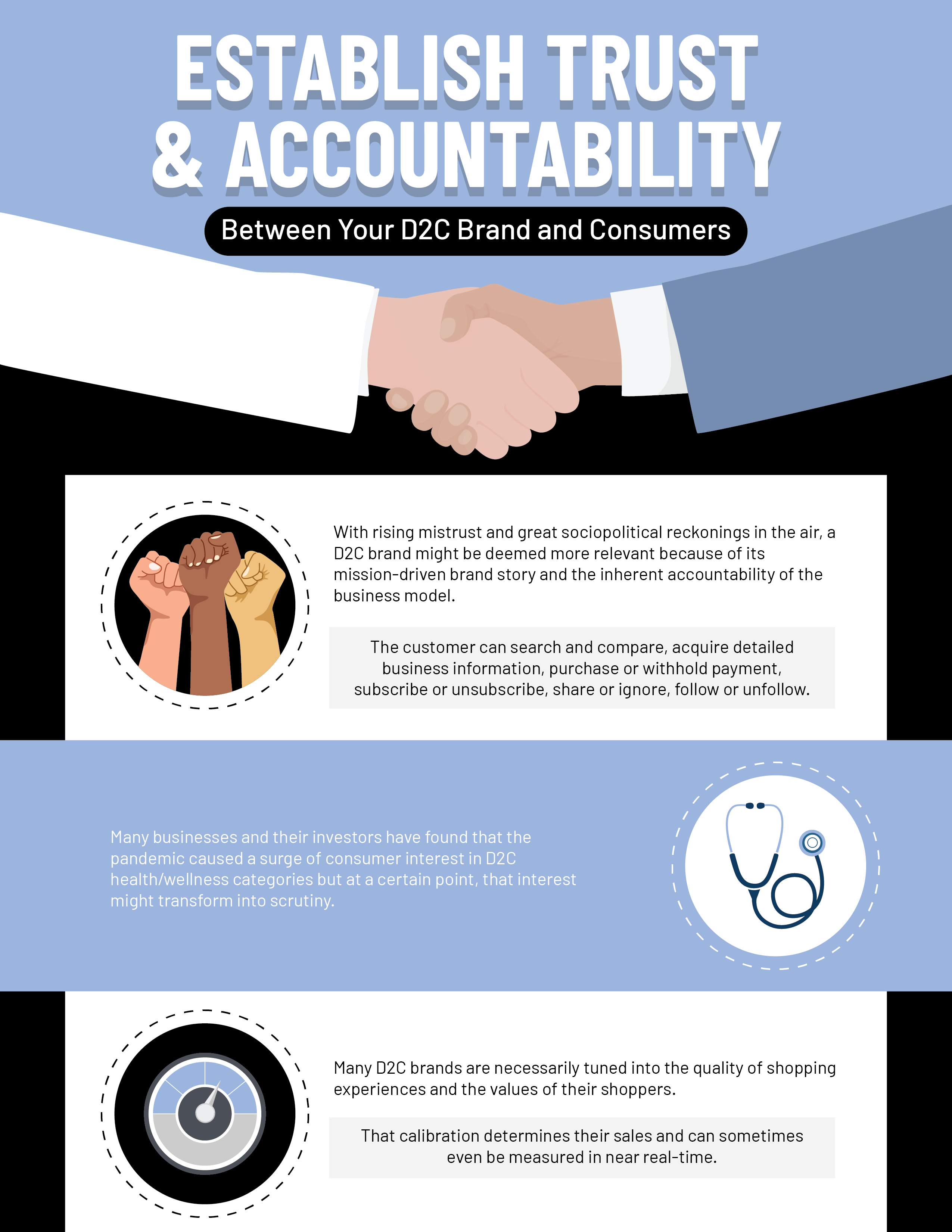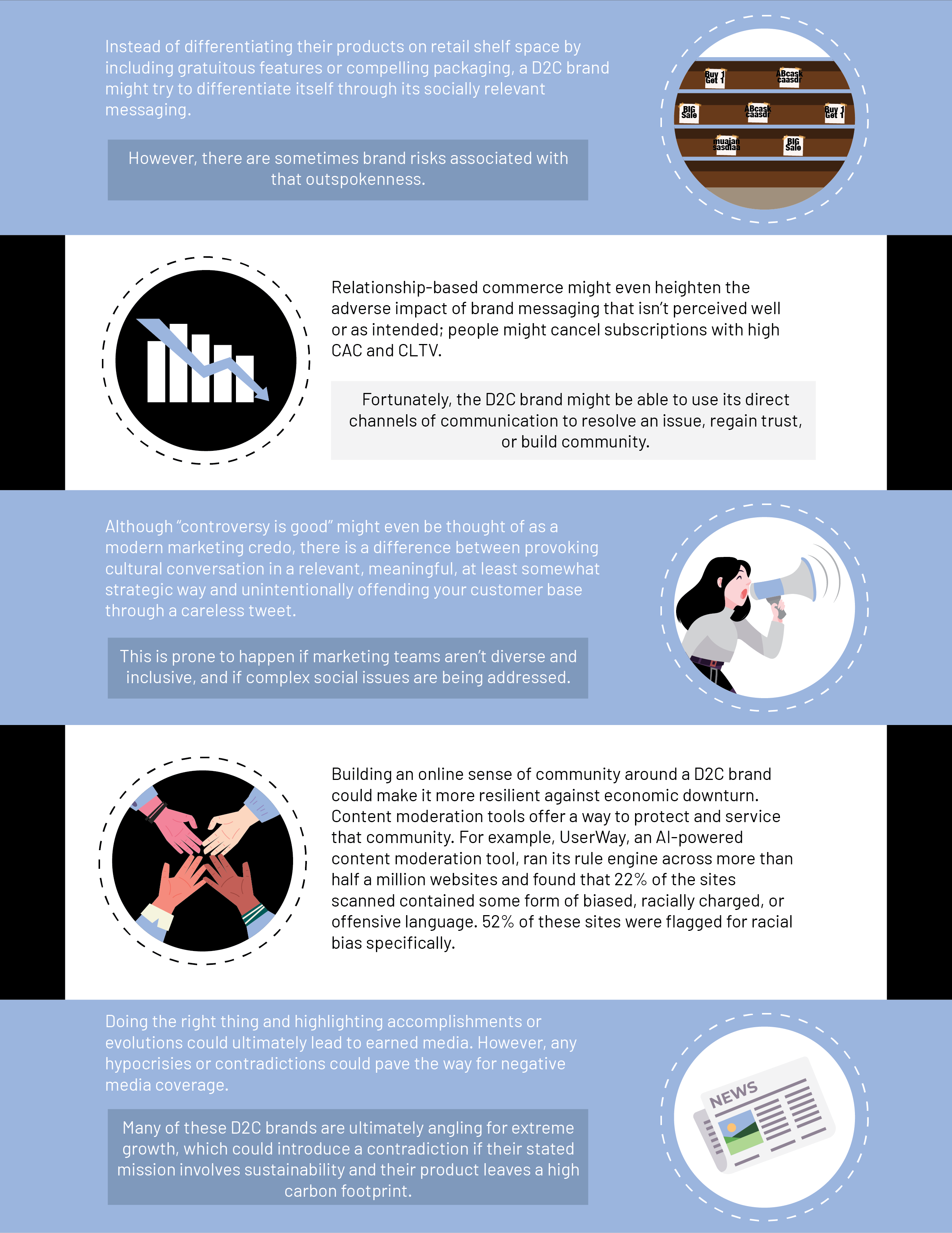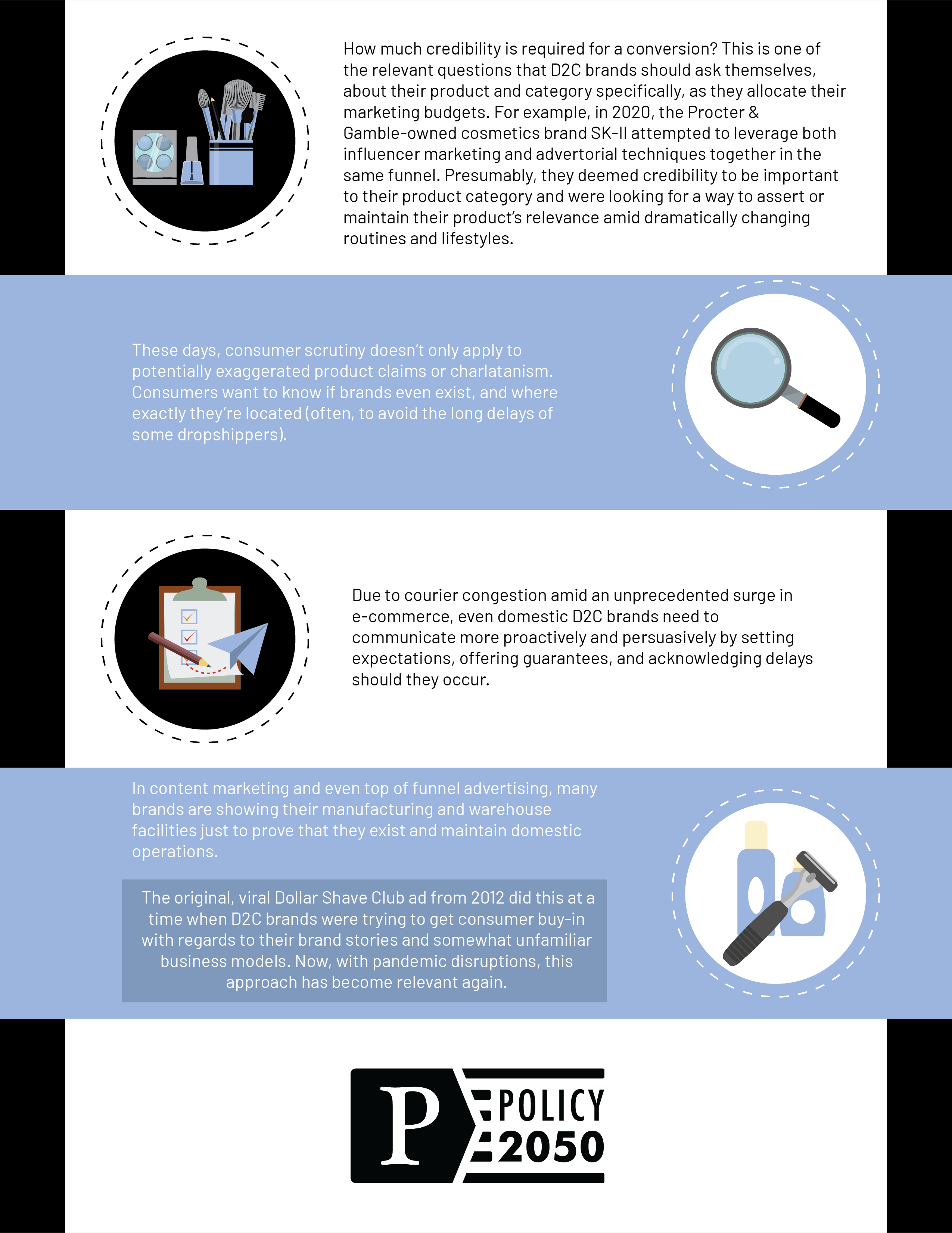By David Pring-Mill
The following text has been excerpted from Sections 3.3—3.3.3 of the Policy2050 report “D2C and Other Digital Adaptations During COVID-19,” in order to serve as a product sample and fulfill Policy2050’s mission “to keep the most socially-relevant insights outside of any paywall.”
Socioeconomic factors
In the current environment, D2C brands must establish trust and accountability with consumers. It has been widely observed that the pandemic exposed pre-existing fissures and problems in our society, including mistrust of public institutions, large corporations, and the media.
António Guterres, the ninth Secretary-General of the United Nations and former prime minister of Portugal, wrote that “the pandemic exposed tremendous shortcomings, fragilities and fault lines” in the world of work. He further suggested that major, corrective measures might be needed, such as a shift of taxation from payroll to carbon, for the sake of “a green, inclusive and resilient recovery.”
With rising mistrust and great sociopolitical reckonings in the air, a D2C brand might be deemed more relevant because of its mission-driven brand story and the inherent accountability of the business model. Consumers can hold these brands accountable by deep researching their options, returning unsatisfying products, posting reviews, subscribing or unsubscribing, following or unfollowing, and sharing or ignoring content.
Many of the established and emerging D2C brands are more socially conscious in their positioning. Winning over consumers, through messaging and service, could mean organic social.
Investor Nik Sharma has commented that a D2C brand can be thought of as “a customer service company that sells a product.”
In other words, many D2C brands are necessarily tuned into the quality of shopping experiences and the values of their shoppers. That calibration determines their sales and can sometimes even be measured in near real-time.
Enabling a range of customer service options ultimately means that customers are free to select the channel on which they feel the least friction. Live chats can be helpful but aren’t always optimal for either party. Through digital resolution methods, customer service tickets can be automatically created and information can be diligently gathered in a semi-automated way, then problem-solved by multiple parties without directly involving the customer.
As a function of trust and accountability, this is arguably better than customer service over the phone, where customers are repeatedly transferred, put on hold, and made to reiterate their frustrations. The latter is almost a deliberate exercise in cementing negative impressions and lowering net promoter scores! And it presumes that the customer has the privilege of being in an environment where they can troubleshoot via a call, in a protracted manner.
Of course, many live chats still have delayed response times but some consumers might find it easier to multitask while they’re waiting.
Differentiation through messaging, risks of offense & tech moderation
By gleaning insights from digital communications, marketing, and usage data, D2C brands can focus on addressing actual wants and needs, instead of altering their product or packaging in a way that is conducive to success in a crowded, increasingly fast-paced retail environment.
A D2C brand might try to differentiate itself through its socially relevant messaging.
In the digital environment, brand messaging and narratives must be broader than purely descriptive product information related to ingredients/components/function. These D2C brands are angling for greater relevance in consumers’ lives, not variety for its own sake.
However, as we’ve seen in a number of recent brand controversies, there are sometimes brand risks associated with that outspokenness. Relationship-based commerce might even heighten the adverse impact of brand messaging that isn’t perceived well or as intended — people might cancel subscriptions with high CAC and CLV.
Although “controversy is good” might even be thought of as a modern marketing credo, there is a difference between provoking cultural conversation in a relevant, meaningful, at least somewhat strategic way and unintentionally offending your customer base through a careless tweet. This is more likely to occur if marketing teams aren’t diverse and inclusive, and if complex social issues are being addressed.
Brands need to determine which risks are acceptable and what lines should never be crossed.

Can technology play a role here?
Creative materials and direct engagement could elevate a D2C brand but this could also backfire if your brand has nothing to say, says something clumsily, or if a lack of sincerity is exposed.
Building an online sense of community around a D2C brand could make it more resilient against economic downturn. Content moderation tools offer a way to protect and service that community.
Allon Mason, Founder and CEO at UserWay, told Policy2050 that his company’s AI-powered content moderation tool can alert website owners about potentially offensive content that is hiding on their own websites, perhaps lurking in the comments or in other forms of user-generated content (UGC).
Bias, hate speech, and offensive terminology should be excluded immediately, he said, so that the brand can focus on defining itself in positive ways.
As the culture changes, reactions to past content will also change; the UserWay product anticipates this with its functionality.
Mason explained, “As the moderator’s dictionary is constantly evolving, these site owners will benefit from a solution that draws their attention to offensive terms that they might not otherwise have changed.”
Prior to its launch, UserWay ran its rule engine across more than half a million websites and found that 22% of the sites scanned contained some form of biased, racially charged, or offensive language. 52% of these sites were flagged for racial bias specifically.
Brands that lose public support for a particular reason may still be able to resolve the issue and regain trust, especially if they’re rooted in a sense of community.
“Direct access to customers might be the fastest way to reverse being canceled, while other brands need to rely on more traditional methods to respond to the criticism,” said Mason.
He forecasted that “ML and AI are only beginning to reveal their true potential to simplify and accelerate interpersonal communication of all kinds, both business and personal.”
Although some recent technological developments may be frightening or concerning, people have already derived benefits from previous technological enhancements of communication.
Mason asked, “Today, who objects to having a spell checker correct annoying typos or having a camera automatically focus?”
Establishing credibility and recurring revenue
The pandemic caused a surge of interest in health/wellness categories and many sales were captured via digital channels but at a certain point, some of that interest might transform into scrutiny. (This is explored in greater depth in the Policy2050 report “D2C in Health/Wellness CPGs, 2021: Strategic, Social, and Policy Considerations.”)
As an article in Elle put it: “COVID has prompted a reckoning within the wellness space, underscoring how difficult it can be to find the line between helpful advice, expertise, and charlatanism.”
Doing the right thing and highlighting accomplishments or evolutions could ultimately lead to earned media. By being very deliberate with PR efforts, sharing captivating imagery that isn’t overly self-promotional, and aiming to fill real knowledge gaps instead of pitching redundant information, D2C startups can significantly improve their chances of soliciting relevant coverage.
However, any hypocrisies or contradictions could pave the way for negative media coverage. Many of these D2C brands are ultimately angling for extreme growth, which could introduce a contradiction if their stated mission involves sustainability and their product leaves a high carbon footprint.
The exact digital strategies utilized by brands might also play a role in consumers’ perceptions of credibility and authenticity.
For example, in 2020, the Procter & Gamble-owned cosmetics brand SK-II partnered with actress Alexandra Daddario for its influencer marketing. In what might be considered an unusual maneuver by other D2C brands that aim for quick conversions, SK-II introduced an additional step in its funnel.
Daddario posted Instagram stories in which she rattled off various skincare benefits from the SK-II Pitera Essence product and briefly addressed the process of application. She instructed followers to swipe up to learn more about how she used the product.
This redirected to an advertorial on Variety that framed Daddario’s usage of the product and self-care/wellness generally in the context of the pandemic. A smaller font above the headline identified this as “partner content.” A link at the bottom of the advertorial directed readers to a D2C site, where the product is included as part of a $99 kit.

The practice of the advertorial is long-running, with the term itself first appearing in 1917, according to Merriam-Webster. In this format, advertisers mimic the structural devices of objective news articles to gain credibility.
Influencer marketing is also largely driven by the perception of authentic recommendations, and the selection of the influencer isn’t exclusively about reach; it’s really a form of targeting.
This SK-II digital campaign attempted to leverage both influencer marketing and advertorial techniques together in the same funnel. Presumably, they deemed credibility to be important to their product category and were looking for a way to assert or maintain their product’s relevance amid dramatically changing routines and lifestyles.
The additional step in the funnel (the advertorial) could introduce some “leakage” to the campaign, versus an immediate link to the D2C site.
However, the high-ticket price of the kit might justify this approach because that additional step might help to convince the prospect, and their margins might be high enough that the leakage doesn’t matter as much.
Other D2C brands have adopted the polar opposite approach by offering steep discounts (often 10-30% for email sign-ups) in order to incentivize quicker conversions.
All D2C brands must ask themselves:
How much credibility is required for a conversion?
This will depend on the specific product and category. The answer is relevant to the selection of strategies and the allocation of marketing budgets. Sometimes, it turns out that there’s a lot of distrust out there, and there are ample reasons as to why.
These days, consumer scrutiny doesn’t only apply to potentially exaggerated product claims or charlatanism. Consumers want to know if brands even exist, and where exactly they’re located.
These consumers have been burnt in the new online environment and are starting to see through dropshippers veiled as D2C brands. They are aware that some sellers might pretend to be local and legitimate, when they’re really operating from a distant location or engaged in some form of misrepresentation.
Given that couriers are already experiencing congestion in some areas due to this huge shift towards ecommerce/D2C, the delays previously associated with shipping from places like China are now exacerbated to the point where the product might not even arrive in time to address a particular need.
Therefore, even domestic D2C brands need to communicate more proactively and persuasively by setting expectations, offering guarantees, and acknowledging delays should they occur.
In content marketing and even top of funnel advertising, many brands are showing their manufacturing and warehouse facilities just to prove that they exist and maintain domestic operations. The original, viral Dollar Shave Club ad from 2012 did this at a time when D2C brands were trying to get consumer buy-in with regards to their brand stories and somewhat unfamiliar business models. Now, with pandemic disruptions, this approach has become relevant again.
Tangentially, dropshipping might not even be viable for those attempting it. And yet, the trend continues. The failure rate has been estimated at 90% or higher. Some purported dropshippers actually make most of their money by selling dropshipping courses to other aspirants.
In contrast to the profit potential of D2C done right, the dropshipping method is ceasing to make sense. Trust and accountability mean profitability in the D2C world. Sellers based in China appear to be losing market share on Amazon, which represents a reversal of the previous trend.
Ordergroove, which integrates with established ecommerce platforms for recurring revenue enablement, found that subscription-based models tend to increase customer spending by 60% or more over the 6 months following enrollment. After partnering with Ordergroove, the recently-acquired food company KIND Snacks experienced upsell conversion rates as high as 21% and an average order value (AOV) increase of 24%.
Some of these successes could be attributed to a “set it, and forget it!” mindset but most customers would likely cancel if they weren’t deriving any value from the subscription.



The full report “D2C and Other Digital Adaptations During COVID-19” is now available for purchase on Policy2050.com.